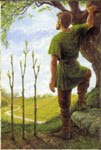But, as in all things, when trying to raise cattle, the hardy homesteaders of Ireland faced many challenges. Their climate was less than ideal. Their soil was thin and unproductive. Their land holdings were tiny and they had many other claims upon their daily labor than tending a needy breed of cattle – usually tending the cow was the job of the wife or an older child.
So, in the nature of things, the Irish began to favor tough, resilient, cows that could handle the Irish weather without lots of pampering or expensive shelter. They looked for calves that were smaller than most because smaller cattle could feed themselves from the tiny patches of pasture a cottage could provide. Also, smaller cattle were more easily handled by women and children. Similarly, cows that were good natured and calm were bred for because you needed that trait if you were likely to have a child looking after the animal.
 Over the millennia, these pressures of land and preferences of the people, led to the breeding of a small, tough, good natured animal. While most of Europe went with bigger, heavier, more productive cattle, the Irish stayed close to their Celtic shorthorn ancestors, brought over nearly 5000 years ago.
Over the millennia, these pressures of land and preferences of the people, led to the breeding of a small, tough, good natured animal. While most of Europe went with bigger, heavier, more productive cattle, the Irish stayed close to their Celtic shorthorn ancestors, brought over nearly 5000 years ago. The two main breeds still active today are the Dexter and Kerry. The Kerry is arguably the older breed. Kerry cattle are black with horns. The Dexter is a little stockier and comes in dun and red as well as black. They are small animals, cows weigh about 750 pounds and bulls less than a 1000. The cows stand about 36 to 42 inches in shoulder height; bulls are slightly larger at 38 to 44 inches. They are small, but as I said earlier they have not been bred to achieve their small size. They have been small for thousands of years. Unlike miniature and dwarf cattle, with large bodies and tiny legs -their body is proportional. Both Kerry and Dexter cows are, well – cute.
Both breeds are sweet natured. Children can easily handle them. They are good grazers, and can live on scrub land that would starve a common cow. From this marginal land they produce from 2 to 4 gallons of milk a day. Their milk has very small globules of fat that makes it easily digested and perfect for cheese production. Also good news for the small landholder, they are agile and can travel safely over rough terrain while doing little damage to their pastures. They are extremely hardy and resistant to most modern ailments. The breeds are also very long lived. Kerry cows are still strong and calving at 14 years of age. Kerry and Dexter beef is held to be excellent. Finally, as an extra bonus, they make excellent draft animals. Bright and friendly, Dexters can be trained to pull plows and light wagons. All and all they are perfect choices for the self sustaining farm or small homestead. Who knew we would have a simple living solution handed to us from the Stone Age.
Now the bad news, A few decades ago there were less than an hundred in the US and less than 800 in Ireland. In the last 25 years, there has been a passionate drive to rebuild the breed. People on both sides of the Atlantic have been fanatically protecting the breed and thanks to modern genetics and artificial insemination they are broadening the gene pool. Today there is almost 15,000 worldwide and over 6000 in North America. It is still not easy to buy a Kerry or Dexter cow, bulls are available and they cross breed well. But it is considered a sin to cross a heritage cow with a modern breed and many current herds will simply not sell their cows. This is getting much easier to do in the last few years and a little diligence will get you your heirloom cow if you look around. Info here
It may be a challenge to find these cattle, but I would think it would be well worth the search. You would be provided your homestead with a triple asset (milk, beef and draft) and be helping to preserve an heirloom breed. As more and more people return to small farms and try homesteading, the demand for this type of cattle is increasing. Hopefully, the ancient breeds will be once again be the treasure to small working farms that they have been for thousands of years.



I love cows. These are lovely.
ReplyDeleteThese are truly pure little gems from the neolithic age. I am trying to convince a friend to start breeding them. Would love to help build their population back.
ReplyDeleteThey are IDEAL for a small homestead